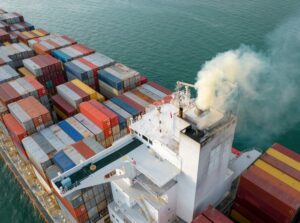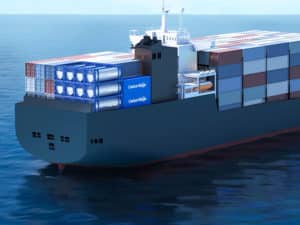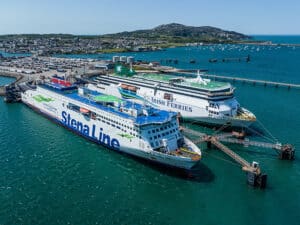
Op-Ed: Change is coming to sustainable shipping
Written by
Jason Berman
Jason Berman, Chief Commercial Officer at S5 Agency World shares five predictions the shipping industry should expect for sustainable shipping in 2023.
Change is a constant in the shipping industry, and this year will see no shortage of challenges as we continue to make strides towards more sustainable shipping efforts and an efficient future. From a global port agency perspective, there are five core areas to expect in the next 10 months and beyond.
Environmental regulation
New regulations on efficiency and carbon intensity from the International Maritime Organization (IMO), and a continued focus on decarbonization across the sector seem to be at the top of everyone’s mind. This includes the Carbon Intensity Indicator (CII) and Energy Efficiency Existing Ship Index (EEXI) measures, effective from 1 January 2023, that require vessels to reduce their Greenhouse Gas emissions.
These regulatory changes show how the shipping industry is becoming more regulated and accountable, and that decarbonization is now an essential consideration for every stakeholder. But it does beg the question—how can we ensure a smooth transition towards the decarbonization of shipping?
For port services providers representing vessels approaching the final mile of their journeys, this means focusing on what can be done to minimize emissions by fully optimizing port visits. Ensuring that all paperwork is available and up to date where and when it is needed helps to avoid unnecessary delays.
By reducing time in port, the prompt administrative action reduces the time a vessel’s auxiliary engines are operating in port, and therefore reduces emissions. As well as improving current behaviors, there are additional services that may be supplied in port, such as connecting to cold ironing facilities as more of these systems come online and vessels are able to make use of them.
As part of the global shipping industry, there is an increasing need to focus on port behaviors ad a vessel’s carbon footprint when in port, as part of vessels’ overall emissions footprints. CII and EEXI have been set to better manage CO2 emissions, and we expect trend for a more sustainable shipping industry to evolve in order to keep up with demand in the future. Better management of emissions in ports have global benefits, and crucially, it benefits port communities with much improved air quality.
The IMO has made it clear that these measures will ratchet up in the coming years. As this happens, operators will need to look at the bigger picture to consider how digitalization can enable better management and measurement of a company’s operations and support decarbonization progress.
The gas supply chain
Last year did see a turbulent gas market, which meant key players were looking for reliable partners to add stability to their own operations. We are now seeing growth in this segment with more players entering the market and taking center stage; including energy companies, cargo owners, terminal owners and shipowners who are interested in fueling their fleets with alternative fuels.
The continuing demand for gas in power and energy systems will see increasing volumes of gas transported via ocean-tankers. In 2022, close to 150 new LNG carriers were ordered over the year, while over the past year major carriers and traders, such as MOL and Proman, continued to announce additions to their methanol carrier fleets throughout the year.
Port calls involving gas carriers are going to increase significantly this year. More than a dozen new LNG terminals are planned in Europe as the continent turns away from gas imports via pipeline, and some terminals have come online—such as in Lubmin where S5 is working with Deutsche ReGas. This change in the gas market and its supply chain will have profound effects on gas terminals and is reflected in the increasing number of gas carriers on order.
Digitalization in ports
The debate surrounding the optimization of port services needs to be an important point on shipping’s agenda, to date it has been largely overlooked. Better data analytics, achieved through digitalization, helps port agencies to move from focusing on productivity alone, to delivering service and support that improves business sustainability for our customers.
Digitalization is also a key component of effectively managing data and creating insight for optimizing operations. This includes reducing the time a vessel spends in port, decreasing the costs associated with any delays, and simplifying information sharing between key teams.
Digital tools improve administration of businesses by reducing delays and inconvenience caused by mislaid information and paperwork. It also makes it easier for operators to measure and compare performance of port calls across different locations, and to identify improvements towards more sustainable shipping.
As a key enabler in decarbonization, digitalization helps deliver more efficient operations with fewer emissions, even before clean tech and future fuels are considered. A digitalized port agency with global coverage and scale will continue to make it easier for operators and cargo owners to manage port calls, confident that essential paperwork, port vendor coordination and payments are available on a timely basis.
In turn, digitalization enhances trust and transparency for all partners involved in the value chain, which will continue to be a watchword for port agencies in 2023.
Transparency in the value chain
Agencies and providers of port services recognize that transparency—the ability for operators, shore staff and port authorities to have easy access to all the information, authorizations and data they need—will be central to the improvement of many important aspects of the shipping industry in 2023.
Agile, trusted and transparent port agencies that can enable a just-In-time vessel arrival, quick departure and minimal emissions footprint, will bring added value to shipping’s ESG score. Being able to access the right information about port calls with ease, convenience and in a timely fashion will help operators to minimize dwell time and reduce emissions. It will allow operators to efficiently achieve just-in-time arrival and will mean businesses can have a better overview of the performance of their fleet when it comes to port calls.
Tapping into talent
Historically, the shipping industry has recruited from within, with shoreside executives frequently being drawn from former seafarers. As the dynamics of the shipping industry continues to evolve, this career path is less common, as operating companies are located and headquartered in locations with dwindling seafarer workforces. This is a challenge and an opportunity; shipping needs to become an attractive place to work for people who would never consider becoming a seafarer. Simultaneously, operators in the industry need to attract new employees who are digital savvy and comfortable with new ways of working while helping them to acquire and develop the experience and expertise of more seasoned colleagues. In this way, ship owners will be able to benefit from young professionals’ passion for sustainability.
There is great enthusiasm and passion from young professionals who are further pushing the green agenda. “Traditional ways” of working may affect a company’s ability to optimize their port services, so it pays to engage the interest of this digitally native new generation and encourage them to embark on a career in shipping.




